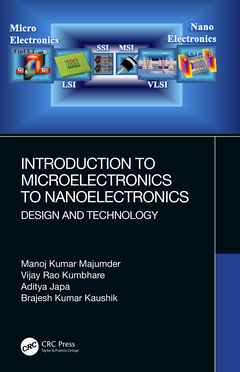Introduction to Microelectronics to Nanoelectronics Design and Technology

Focussing on micro- and nanoelectronics design and technology, this book provides thorough analysis and demonstration, starting from semiconductor devices to VLSI fabrication, designing (analog and digital), on-chip interconnect modeling culminating with emerging non-silicon/ nano devices. It gives detailed description of both theoretical as well as industry standard HSPICE, Verilog, Cadence simulation based real-time modeling approach with focus on fabrication of bulk and nano-devices. Each chapter of this proposed title starts with a brief introduction of the presented topic and ends with a summary indicating the futuristic aspect including practice questions. Aimed at researchers and senior undergraduate/graduate students in electrical and electronics engineering, microelectronics, nanoelectronics and nanotechnology, this book:
- Provides broad and comprehensive coverage from Microelectronics to Nanoelectronics including design in analog and digital electronics.
- Includes HDL, and VLSI design going into the nanoelectronics arena.
- Discusses devices, circuit analysis, design methodology, and real-time simulation based on industry standard HSPICE tool.
- Explores emerging devices such as FinFETs, Tunnel FETs (TFETs) and CNTFETs including their circuit co-designing.
- Covers real time illustration using industry standard Verilog, Cadence and Synopsys simulations.
Manoj Kumar Majumder received his PhD from Microelectronics and VLSI group at Indian Institute of Technology, Roorkee, India. Currently, he is working as assistant professor in Department of Electronics and Communication Engineering, IIIT Naya Raipur, Chhattisgarh. He has authored more than 25 papers in peer-reviewed international journals and more than 40 papers in international conferences. He has co-authored a book titled Carbon Nanotobe Based VLSI Interconnects-Analysis and Design (New York, NY, USA: Springer, 2014) and a book-chapter published by CRC Press. His current research interests include the area of graphene based Low power VLSI devices and circuits, On-chip VLSI interconnects and Through silicon vias. Dr. Majumder is associated with different academic and administrative activities of different positions in IIIT, Naya Raipur. He is an active member of IEEE, IEEE Electron Device Society and IEEE Circuits and Systems Society. He had delivered technical talks at different conferences in India and abroad. He is also an active reviewer of IEEE Transactions on electromagnetic Compatibility, IEEE Transactions on Nanotechnology, IEEE Electron Device Letters, Microelectronics Journal, IET Micro & Nano Letters, and other Springer Journals. He is a Member of many expert committees constituted by Government and Nongovernment organizations. He has also received many awards and recognitions from International Biographical Center, Cambridge, etc. His name has been listed in Marquis Who’s Who in the World.
Vijay Rao Kumbhare received the B.Tech degree in Electronics and Telecommunication Engineering from National Institute of Technology, Raipur, India in 2008, and M.Tech degree with specialization of Telecommunication System Engineering (TSE) under Electronics and Engineering Communication Department from Indian Institute of Technology, Kharagpur, West Bengal, India, in 2011. He had worked experience as assistant professor more than 5 years. He is currently
Date de parution : 09-2023
15.6x23.4 cm
Date de parution : 11-2020
15.6x23.4 cm
Thèmes d’Introduction to Microelectronics to Nanoelectronics :
Mots-clés :
CMOS Inverter; nanoelectronics; Power Consumption; industry standard HSPICE tool; Metal Oxide Semiconductor Field Effect Transistor; very-large-scale integration design; Drain Current; Verilog hardware description language; Channel Length Modulation; microelectronics; GNR; Interconnect Line; MOSFET Model; Carbon Nanotube FET; MOS Capacitor; MOS Transistor; Verilog Hdl; TFET; ATPG; Voltage Transfer Characteristics; Static CMOS; Delay Fault; ABCD Parameter; PN Diode; Pass Transistor Logic; Metallization Process; Elmore Delay; Subthreshold Swing; Constant Voltage Scaling; MOS Switch



